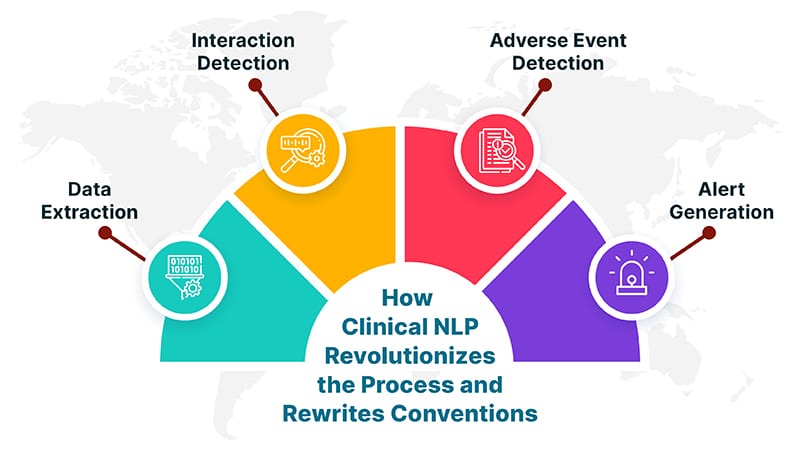The introduction of emerging technologies has opened up incredible avenues for super-focused R&D and innovation in healthcare. As tech concepts like data science, Artificial Intelligence (AI) and its niche subsets like Machine Learning, NLP (Natural Language Processing) and more gain prominence, the volume of radical advancements in drug discovery, clinical trial simulations, and more has increased exponentially.
One of the most resourceful applications of NLP lies in identifying medication interactions and the probability of adverse events through the application of clinical NLP. This exclusive article takes a deep-dive approach to decoding the various aspects associated with this.
So, let’s get started.
The Problem Statement
Medication interactions and adverse events (ADEs) are a significant safety concern in healthcare. They can lead to serious health consequences, including hospitalization, disability, and even death. Identifying these issues early is crucial to prevent adverse outcomes and ensure patient safety.
Challenges Involved In Traditional Approach
- Identifying potential medication interactions and ADEs currently relies on manual review of prescriptions and medical records by healthcare professionals.
- This process is time-consuming, labor-intensive, and prone to human error.
- It also requires expertise in pharmacology and knowledge of potential interactions between different medications.
How Clinical NLP Revolutionizes The Process and Rewrites Conventions

Clinical NLP offers a powerful solution to address challenges posed by conventional methodologies. NLP algorithms can analyze vast amounts of unstructured text data within EHRs, including prescriptions, clinical notes, and lab reports. This enables the automated identification of potential medication interactions and ADEs, significantly improving efficiency and accuracy.
Here’s an extensive breakdown of how it works:
Data Extraction
NLP models extract relevant information from EHRs, such as
- medication names
- Dosages
- Allergies
- Diagnoses
- and clinical observations
Interaction Detection
The extracted data is then analyzed against a comprehensive database of known drug interactions. NLP algorithms can identify potential interactions based on established criteria, including pharmacological properties, metabolic pathways, and patient-specific factors.
Adverse Event Detection
NLP can analyze clinical notes and lab reports to identify patterns and keywords suggestive of ADEs. This involves looking for specific symptoms, changes in vital signs, or laboratory results that might be associated with a specific medication.
Alert Generation
Once potential interactions or ADEs are identified, NLP systems can automatically generate alerts for healthcare professionals. These alerts typically include details about the interaction or ADE, the level of risk involved, and recommended actions.
Benefits of using Clinical NLP for Medication Safety

Advantages are aplenty when it comes to deploying clinical NLP for drug safety. Let’s look at some of the most prominent ones.
- Improved Efficiency: By automating the identification of potential interactions and ADEs, this technique frees up healthcare professionals’ time to focus on patient care.
- Increased Accuracy: Reduces the risk of human errors stemming from manual identification methods.
- Proactive Intervention: Enables early detection of potential issues, paving the way for timely interventions to prevent harm.
- Pharmacovigilance: Monitors population-level AE trends for drug safety evaluation.
- Personalized Risk Assessment: It optimizes risk assessment by considering factors such as age, medical history, and concurrent medications for more accurate risk assessment.
- Enhanced Reporting: Provides a bird’s eye view on identified interactions and ADEs, facilitating data analysis and quality improvement initiatives.
Clinical NLP: A Tangible Reality
Real-world Impact I
A major hospital implemented an NLP system to analyze EHRs and identify potential medication interactions. The system identified over 1,000 potential interactions in just one year, preventing an estimated 500 adverse events.
Real-world Impact II
A healthcare organization used NLP to analyze clinical notes and lab reports to detect potential ADEs. The system identified a case of early kidney damage caused by a medication, allowing for prompt intervention and preventing further harm to the patient.
Clinical NLP Tools
| Open-source NLP libraries | spaCy, NLTK |
| Medical NLP libraries | MedSpaCy, ctakes |
| Drug interaction databases | Micromedex, Lexicomp |
| AE reporting systems | FDA Adverse Event Reporting System |
Challenges Involved In Implementing Clinical NLP
Any technology, at its nascent stages, poises certain bottlenecks during implementation stages. Its through agility and iterative optimizations that they get better. Clinical NLP is no exception. Still in development and advancement, clinical NLP could throw limitations to stakeholders in the form of:
- Data quality and heterogeneity, where inconsistent data formats and incomplete information can hinder accuracy
- Complex medical relationships: Interactions and AEs can be nuanced and require sophisticated analysis.
- Model-specific limitations: Current models may not capture all relevant information or context.
The Future Of Clinical NLP
Immensely promising is the right word that defines the future of clinical NLP. With more research and niche use cases, the technology holds value to stand rooted to further revolutionize clinical processes and drug discovery and interaction techniques.
In the coming months and years, we foresee the following diversification of clinical NLP:
- Integration with clinical decision support systems to provide real-time alerts to healthcare professionals at the point of care, further enhancing medication safety.
- Analyze patient-generated data, such as medication adherence and side effect reports, to provide a more comprehensive picture of medication safety.
- Develop personalized medication management plans that take into account individual patient risks and preferences.
Clinical NLP offers a powerful and promising approach to improving medication safety. Its ability to automate and streamline the identification of potential interactions and ADEs can significantly reduce the risk of harm to patients and improve the overall quality of healthcare. As NLP technology continues to advance, its applications in medication safety are expected to grow even further, leading to a safer and more effective healthcare system for everyone.




